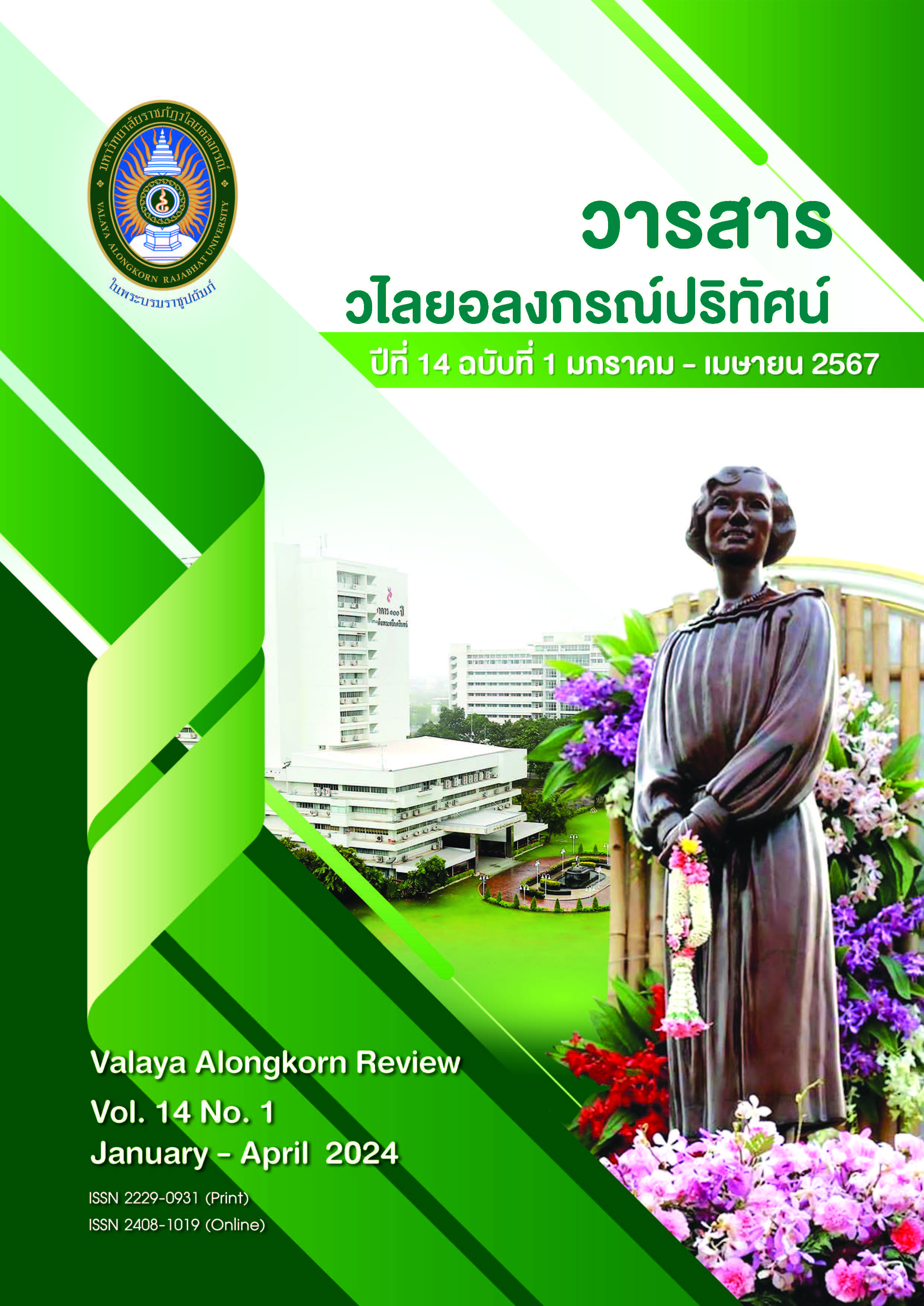แนวทางการขับเคลื่อนธุรกิจบริการเพื่อผู้สูงอายุ ในยุคเศรษฐกิจดิจิทัล
คำสำคัญ:
คุณภาพการบริการ, สังคมผู้สูงอายุ, เศรษฐกิจดิจิทัล, ธุรกิจบริการบทคัดย่อ
การวิจัยนี้มีวัตถุประสงค์เพื่อศึกษา (1) ปัจจัยที่มีอิทธิพลต่อการขับเคลื่อนธุรกิจบริการผู้สูงอายุในยุคเศรษฐกิจดิจิทัล (2) ความสัมพันธ์ระหว่างปัจจัยที่มีอิทธิพลต่อการขับเคลื่อนธุรกิจบริการผู้สูงอายุกับคุณภาพการให้บริการในยุคเศรษฐกิจดิจิทัล และ (3) เพื่อเสนอแนวทาง การขับเคลื่อนธุรกิจบริการผู้สูงอายุในยุคเศรษฐกิจดิจิทัล โดยกระบวนการวิจัยใช้วิธีการรวบรวมข้อมูลจากการทบทวนวรรณกรรม งานวิจัยที่เกี่ยวข้อง บทความ ฐานข้อมูลออนไลน์ เพื่อสังเคราะห์ปัจจัย ที่มีอิทธิพลต่อการขับเคลื่อนธุรกิจบริการเพื่อผู้สูงอายุ โดยรวบรวมข้อมูลและวิเคราะห์ตามทฤษฎีคุณภาพการให้บริการ 5 มิติ
ผลการวิจัย พบว่าปัจจัยการมุ่งเน้นความเป็นผู้ประกอบการ ปัจจัยการมุ่งเน้นนวัตกรรมและเทคโนโลยี และปัจจัยการมุ่งเน้นความเป็นเครือข่าย มีผลกระทบต่อคุณภาพการให้บริการและ มีอิทธิผลต่อการขับเคลื่อนธุรกิจบริการในยุคเศรษฐกิจดิจิทัล โดยที่ปัจจัยทั้งสามมีความสัมพันธ์ต่อกัน แนวทางการขับเคลื่อนธุรกิจบริการเพื่อผู้สูงอายุ ตามกรอบคุณภาพการให้บริการ 5 มิติ ได้แก่ การบริการที่มีความเสมอภาค มีการประเมินและวางแผนการบำบัดรักษาเป็นระยะ มีมาตรฐาน การให้บริการ มีการกำหนดแนวทางการปฏิบัติงานที่ชัดเจน มีการออกแบบพื้นที่ใช้สอยทางกายภาพให้เหมาะสมกับผู้สูงอายุ มีระบบสำรองเครื่องมือและวัสดุพร้อมที่ให้บริการตลอดเวลา และวิเคราะห์ความต้องการและความคาดหวังของสูงอายุ
เอกสารอ้างอิง
กรมการปกครอง. (2565). สถิติผู้สูงอายุไทยปี 2565. (ออนไลน์), เข้าถึงได้จาก https://stat.bora.dopa.go.th/new_stat/webpage/statbyagemonth.php (2566, 5 มกราคม)
กรมพัฒนาธุรกิจการค้า กระทรวงพาณิชย์. (2562). กองธุรกิจบริการฝ่ายพัฒนาธุรกิจบริการ. [ออนไลน์], เข้าถึงได้จาก: https://www.smethailandclub.com.entrepreneur-4924-id.html (2566, 5 มีนาคม)
กมลชนก ขำสุวรรณ และมาดี ลิ่มสกุล. (2560). คุณค่าของผู้สูงอายุในระบอบของความเป็นจริง: ความท้าทาย ของนักวิจัยด้านสังคมศาสตร์ในปัจจุบัน. วารสารสังคมสงเคราะห์ศาสตร์. 25(1): 133-156.
กาญจนา แสงลิ้มสุวรรณ. (2555). นวัตกรรมทางสังคม. วารสารนักบริหาร. 32(3): 12-15.
ขจรศักดิ์ วงศ์วิราช และบุญฑวรรณ วิงวอน. (2563). อิทธิพลของภาวะการเป็นผู้ประกอบการ การบูรณาการ องค์ความรู้และนวัตกรรมที่มีต่อผลการดำเนินงานของวิสาหกิจชุมชนในพื้นที่ภาคเหนือตอนบน. วารสารศิลปการจัดการ. 4(2): 308-324.
คัมภิรัตน์ แก้วสุวรรณะ. (2560). นวัตกรรมสังคมด้านพฤฒพลัง ในการพึ่งตนเองของผู้สูงอายุในจังหวัดนครราชสีมา. วารสารรังสิตบัณฑิตศึกษาในกลุ่มธุรกิจและสังคมศาสตร์. 2(2): 28-42.
จารุวรรณ ศรีภักดี. (2565). การขับเคลื่อนมาตรการรองรับสังคมสูงวัยคนไทยอายุยืนของประเทศไทยไปสู่การปฏิบัติอย่างมีคุณภาพ. [ออนไลน์], เข้าถึงได้จาก: https://www.dop.go.th/download/knowledge/th1658208320-1649_0.pdf (2566, 24 มกราคม)
โรจนศักดิ แสงธศิริวิไล. (2564). การบริหารการจัดการธุรกิจบริการดูแลสุขภาพสำหรับผู้สูงอายุเพื่อเพิ่มศักยภาพทางการแข่งขันทางธุรกิจ เขตกรุงเทพมหานครและปริมณฑล. วารสารวิทยาลัยพาณิชยศาสตร์บูรพาปริทัศน์. 13(2): 1-19.
วิไล ตาปะสี และคณะ. (2560). รูปแบบการจัดบริการการดูแลสุขภาพผู้สูงอายุโดยการมีส่วนร่วมของชุมชนตำบลวังตะกู จังหวัดนครปฐม. วารสารเกื้อการุณย์. 24(1): 42-43.
ธร สุนทรายุทธ. (2553). การบริหารจัดการเชิงจิตวิทยา: หลักการ การประยุกต์ และกรณีศึกษา. กรุงเทพฯ: บริษัทเนติกุลการพิมพ์.
Acs, Z. J. & Armington, C. (2006). Entrepreneurship, Geography and American Economic Growth. New York: Cambridge University Press.
Amaia, C. L. (2018). Does our Healthcare System truly Fit Older People. [Online], Available: https://ki-su-arc.se/researchareas/does-our-healthcare-system-truly-fit-older-people-impact-of multidimensional-health-trajectories-on-the-use-of-medical-and-socialcare-services. (January 17, 2019)
Annica, B. (2018). Leadership Person - centred care and the work situation of staff in Swedish nursing homes. [Online], Available: http://umu.divaportal.org/smash/get/diva2:1196831/FULLTEXT01.pdf. (2019, 15 January)
Bates, K. A. & Flynn, E. J. (1995). Innovation History and Competitive Advantage: A Resource-based view Analysis of Manufacturing Technology Innovations. Academy of Management Journal. 1995(1): 235-239.
Bettina, M. (2017). Longer lives, healthier lives? Patterns of Severe Health problems and Dependency in the last years of life. [Online], Available: https://ki-su-arc.se/research-areas/longer-lives-healthier-livespatterns-of-severe-health-problems-and-dependency-in-the-last-yearsof-life/
Chesbrough, H.W. (2003). Open Innovation. “The New Imperative for Creating and Profiting from Technology.” Harvard Business School Press, Boston, MA.
Costa, A. A. & Tavares, L. V. (2012). Social E-Business and the Satellite Network Model: Innovative Concepts to Improve Collaboration in Construction. Automation in Construction. 22, 387-397.
Department of Nursing. (2017). Exploring Resident thriving in Swedish Nursing homes The Ume Ageing and Health research Program me (U - Age). [Online], Available: http://umu.diva-portal.org/smash/get/diva2:1138659/FULLTEXT01.pdf. (2023, 16 January)
Department of Older Persons. (2018). The Elderly Strategic 20 years. [Online], Available: https://www.dop.go.th/download/Knowledge/th1539326153-138 (In Thai). (2023, 20 January).
Drucker, P. F. (1994). Innovation and Entrepreneurship: Practice and Principles. London: Heinemann.
Essays, U. K. (2018). Marketing Strategies of Tesco. [Online], Available: https://www.ukessays.com/assignments/marketing - strategies - tesco.php?vref (2023, 15 January)
Frese, Michael. (2000). Success and Failure of Micro business Owners in Africa: A Psychological Approach. United States of America: Greenwood Publishing Group.
Heck, E. V. & Vervest, P. (2009). Smart Business Networks: Concepts and empirical evidence. Decision Support Systems. 47(4): 275–276.
Henard, D. H. & Szymanski, D. M. (2001). Why some New Products Are More Successful than Others. Journal of Marketing Research. 38(3): 362-375.
Jay, W. & Leonard, C. (2001). An Empirical Investigation into Entrepreneurship and Organizational Innovation-based Competitive Strategy. Journal of Research in Marketing & Entrepreneurship. 3(1): 51-70.
Jefferson, S., & Tanton, S. (2015). Valuable Content Marketing how to make quality Content Your key to Success. London: Kogan Page.
Dawson, J., Findlay, A. & Sparks, L. (2008). The Retailing Reader. London: The Cromwell Press, Trowbridge.
Kai, L. (2019). Dance in Elderly Care: Professional Knowledge. Journal of Dance Education. 19(3): 1-9.
Kyndt, E., & Baert, H. (2015). Entrepreneurial Competences: Assessment and Predictive value for Entrepreneurship. Journal of Vocational Behavior. 90(October 2015): 13- 25.
Lane, N. (1999). Advancing the Digital Economy into the 21st Century. Information Systems Frontiers. 1(3): 317 - 320.
Lengrand, L. & Chatrie, I. (1999). An Empirical Study Carried out in Europe and Canada. Luxemburg: European Community.
Mowery D. C. & Rosenberg, N. (1978). The Influence of Market Demand upon Innovation: A critical Review of some recent empirical studies. 8(2): 102-153.
Nations, D. (2017). What is Social Media? Explaining the Big Trend. [Online], Available: https://www.lifewire.com/what-is-social-media-explaining-the-big-trend3486616 (2019, 30 October)
Nancy, D. (2019). Older Adult Caregivers’ Lived Experiences with Debilitated Chronically Ill Relatives in a Rural Southern County. In An Applied Dissertation Submitted to the Abraham S. Fischler College of Education in Partial Fulfillment of the Requirements for the Degree of Doctor of Education. Nova Southeastern University.
North, D., & Smallbone, D. (2000). The Innovativeness and Growth of Rural SMEs During the 1990s. Regional Studies, 34: 145-157.
Noshad, R. (2018). Developing a Mixed - Methods Method to Model Elderly Health Technology Adoption with Fuzzy Cognitive Map and its Application in Adoption of Remote Health Monitoring Technologies by Elderly Women. In A Dissertation Submitted in Partial Fulfillment of The Requirements for The Degree of Doctor of Philosophy in Technology Management. Portland State University.
Pär, S. (2017). Why do Older people Seek Emergency Care. Causes, Circumstances and explanations. [Online], Available: https://ki-su-arc.se/research- areas/why-do-older-people-seekemergency-care- causes-circumstances-and-explanations/ (2019, 16 January)
Parasuraman, V. A., Zeithaml, & Berry, L. L. (1985). A Conceptual Model of Service Quality and its implications for future research. Journal of Marketing. 49(4): 41-50.
Porter, M. E. (1990). The Competitive Advantage of Nations. Harvard Business Review. 68: 73-93.
Siguaw, J. A., Simpson, P. M., & Enz, C. A. (2006). Conceptualizing Innovation Orientation: A Framework for Study and Integration of Innovation Research. Journal of Product Innovation Management. 23: 556-574.
Tapscott, D. (1996). The Digital Economy: Promise and Peril in the Age of Networked Intelligence. New York: McGraw-Hill.
United Nations. (2008). World Population Policies 2007. New York: Population Division, Department of Economic.
Wang, C. L., & Ahmed, P. K. (2004). The Development and Validation of the Organizational Innovativeness Construct using Confirmatory Factor Analysis. European Journal of Innovation Management. 7(4): 303-313.
World Health Organization. (2010). Home-Based Long-Term Care. In Report of a WHO Study Group: Home - Based Long - Term Care. Geneva: World Health Organization.
Zairi (2000). Information and Business Process Equality: The Case of SAP R/3 Implementation. The Electric Journal on Information System in Developing Countries. 2(4): 1-15.
ดาวน์โหลด
เผยแพร่แล้ว
รูปแบบการอ้างอิง
ฉบับ
ประเภทบทความ
สัญญาอนุญาต
ลิขสิทธิ์ (c) 2024 ศิริพงษ์ ฐานมั่น

อนุญาตภายใต้เงื่อนไข Creative Commons Attribution-NonCommercial-NoDerivatives 4.0 International License.
ข้อความที่ปรากฏในบทความแต่ละเรื่องในวารสารวไลยอลงกรณ์ปริทัศน์ เป็นความคิดเห็นของผู้นิพนธ์แต่ละท่าน มิใช่เป็นทัศนะและมิใช่ความรับผิดชอบของกองบรรณาธิการจัดทำวารสาร และ
มหาวิทยาลัยราชภัฏวไลยอลงกรณ์ ในพระบรมราชูปถัมภ์


